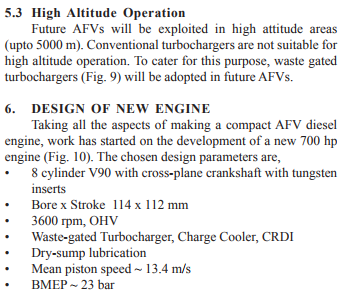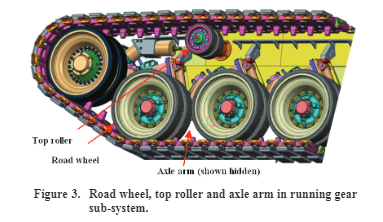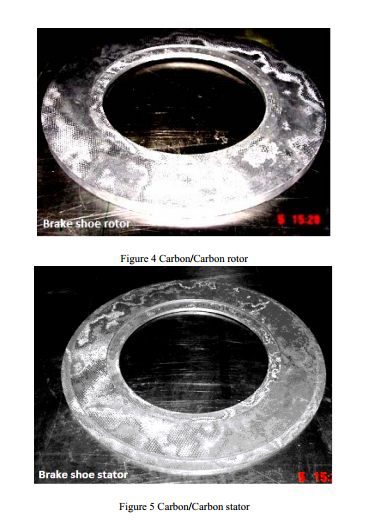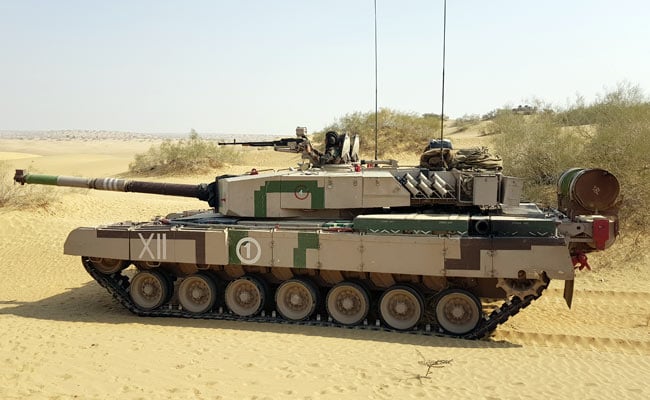T
Tarun
Arjun Mk II 2 main battle tank technical data sheet specifications pictures

Description
The Arjun Mk-2 is a new generation of main battle tank (MBT) designed and developed by the Defence Research and Development Organization (DRDO) of India. The Arjun Mk II was unveiled for the first time to the public during a military parade for the National Day in New Delhi on 26 January, 2014. The state-of-the-art ARJUN Main Battle Tank Mk II has been designed and developed by DRDO by incorporating numerous improvements over and above the ARJUN MBT Mk I which is already in service with the Indian Army. It is endowed with superior fire power, high mobility and excellent protection characteristics required to fulfil the challenging battlefield requirements of the 2 Ist century. ARJUN MBT Mk II manifests the latest battle tank technologies that makes it a distinct front-runner amongst the array of contemporary Main Battle Tanks of modern armies the world over. The Arjun Mk II has excellent mobility characteristics that have proved its worth while operating in highly demanding Indian desert conditions. Low ground pressure, high power to weight ratio and a high performance powerpack, including a robust and effective transmission system characterize the Arjun Mk II MBT's remarkable mobility. DRDO had recently launched its Arjun Mk-II for user trials in Rajasthan after integrating the same with almost 75-80 improved features including 16 major technologies as sought by the Indian Army which has already inducted 124 of the Arjun Mk-I tanks. DRDO has been developing Arjun MBT with help of its various labs led by Chennai-based Combat Vehicle Research and Development Establishment (CBRED) while Hyderabad-based Defence Metallurgical Research Laboratory of DRDO has developed the armour for Mk II version of Arjun. The development trials have been on for the past more than two years.
Main Variants
- Arjun Mk-I: first variant of the Indian-made main battle tank.
Technical Data
Armament
The main armament of the Arjun Mk II main battle tank comprises a 120mm rifled gun fitted with a thermal sleeve, fume extractor, and a muzzle reference system. The gun is able to fire a full range of ammunitions including FSAPDS (Fin Stabilized Armour Piercing Discarding Sabot), HESH (High-Explosive Squash Head), PCB, TB and the Israeli LAser Homing Anti-Tank (LAHAT) missile. LAser Homing Attack Missile, or LAHAT, is an advanced missile developed and manufactured by the MBT Division of Israel Aerospace Industries (IAI). The missile uses a tandem warhead which is capable of defeating all types of modern armour, including add-on reactive armour. High penetration capability of the main warhead allows the missile to penetrate the armour of major armoured vehicles at high impact angles. The Arjun Mk II can carry a total of 39 rounds in special blast-proof canisters. A 7.62 mm MAG machine gun is mounted coaxially to the main armament. A Remote Controlled Weapon Station is mounted on the top of the turret armed with a 12.7mm NSVT machine gun. This type of turret enhances crew survivability by enabling firing of the anti-aircraft gun in hatch closed mode during day and night. The vehicle is also fitted with a bank of eight 81 mm grenade launchers mounted on each side at the rear part of the turret.

A remote weapon station armed with a 12.7mm machine gun is mounted on the top of the turret.
Design and protection
The overall layout of the Arjun Mk II is similar to other main battle tanks, with the driver's compartment at the front, three-man turret in the centre and engine and transmission at the rear. The Arjun Mk II has a crew of four, including commander, gunner, loader and driver. The driver has a seat which provides added protection in the eventuality of a mine blast. The front part of the chassis and the turret are fitted with an integrated explosive reactive armor (ERA) system. The all-round protection has been enhanced with improved KANCHAN armour, a modular composite armour developed by India. It has been described as being made by sandwiching composite panels between Rolled homogeneous armour (RHA). This armour is able to defeat APDS and HEAT rounds and is believed to withstand APFSDS.

Each side of the turret is fitted with explosive reactive armour.
Propulsion
The Arjun MK II is motorized with a German 10 cylinder, V-90 turbo charged, charge cooled, water cooled diesel engine developing 1030 kW at 2,400 rpm. The Arjun Mk II is equipped with epicyclic transmission with hydrodynamic torque converter, mechanical lock up clutch and hydrodynamic retarder with 4 forward and 2 reverse gears. The tank can run at maximum road speed of 58 km/h and 40 km/h in cross country with a maximum cruising range of 500 km. The advanced hydropneumatic suspension consists of each side of seven dual rubber-tyred roadwheels with the drive sprocket at the rear, idler at the front and track-return rollers. The upper-part of the suspension is protected by armour plates. To increase the cruising range of the tank, two diesel fuel drums are fitted at the rear of the hull. The Arjun Mk II can negotiate a gradient of 30% and vertical step of 910 mm. It can cross natural or man-made trenches 2,430 mm wide. The tank can cross a water obstacle of 1.4 m depth without preparation and 2.15 m with a kit.

Two diesel fuel drums are fitted at the rear of the hull.
Accessories
The Arjun Mk II is fitted with a computerized day/thermal fire control system and a new panoramic sighting system for the commander is mounted right side of the turret roof. The system includes a laser range finder and has hunter-killer capability. The gunner sight is fitted with an automatic target tracker which greatly enhances the speed and accurate target engagement capability of the tank. To increase the self-protection of the Arjun Mk-II, a laser warning and countermeasure system (ALWACS) developed in collaboration with the Israeli Company Elbit Systems is mounted on each side of the turret. The four ALWACS elements are mounted at each corner of the turret to provide 360-degree coverage. The system detects and classifies laser threats and fire smoke grenades from an independent rotary launcher. The front of the chassis equipped with a track width mine plough to give the vehicle the ability to rapidly force a passage through a mined obstacle by creating a cleared path for it tracks to follow. Standard equipment of the Arjun Mk II includes also a thermal night vision sight for the driver, and advanced land navigation system which provides Inertial and GPS based navigation, NBC protection system, fume extractor system, auxiliary power unit and integrated fire detection and suppression system. The Arjun Mk.2 is also fitted with auxiliary power unit which powers all systems when the main engine is turned off.

The front of the chassis is equipped with a track width mine plough.

Arjun Mk II 2 main battle tank technical data sheet specifications pictures video intelligence | India Indian army tanks heavy armoured vehicles UK | India Indian army military equipment vehicle UK

Description
The Arjun Mk-2 is a new generation of main battle tank (MBT) designed and developed by the Defence Research and Development Organization (DRDO) of India. The Arjun Mk II was unveiled for the first time to the public during a military parade for the National Day in New Delhi on 26 January, 2014. The state-of-the-art ARJUN Main Battle Tank Mk II has been designed and developed by DRDO by incorporating numerous improvements over and above the ARJUN MBT Mk I which is already in service with the Indian Army. It is endowed with superior fire power, high mobility and excellent protection characteristics required to fulfil the challenging battlefield requirements of the 2 Ist century. ARJUN MBT Mk II manifests the latest battle tank technologies that makes it a distinct front-runner amongst the array of contemporary Main Battle Tanks of modern armies the world over. The Arjun Mk II has excellent mobility characteristics that have proved its worth while operating in highly demanding Indian desert conditions. Low ground pressure, high power to weight ratio and a high performance powerpack, including a robust and effective transmission system characterize the Arjun Mk II MBT's remarkable mobility. DRDO had recently launched its Arjun Mk-II for user trials in Rajasthan after integrating the same with almost 75-80 improved features including 16 major technologies as sought by the Indian Army which has already inducted 124 of the Arjun Mk-I tanks. DRDO has been developing Arjun MBT with help of its various labs led by Chennai-based Combat Vehicle Research and Development Establishment (CBRED) while Hyderabad-based Defence Metallurgical Research Laboratory of DRDO has developed the armour for Mk II version of Arjun. The development trials have been on for the past more than two years.
Main Variants
- Arjun Mk-I: first variant of the Indian-made main battle tank.
Technical Data
Armament
The main armament of the Arjun Mk II main battle tank comprises a 120mm rifled gun fitted with a thermal sleeve, fume extractor, and a muzzle reference system. The gun is able to fire a full range of ammunitions including FSAPDS (Fin Stabilized Armour Piercing Discarding Sabot), HESH (High-Explosive Squash Head), PCB, TB and the Israeli LAser Homing Anti-Tank (LAHAT) missile. LAser Homing Attack Missile, or LAHAT, is an advanced missile developed and manufactured by the MBT Division of Israel Aerospace Industries (IAI). The missile uses a tandem warhead which is capable of defeating all types of modern armour, including add-on reactive armour. High penetration capability of the main warhead allows the missile to penetrate the armour of major armoured vehicles at high impact angles. The Arjun Mk II can carry a total of 39 rounds in special blast-proof canisters. A 7.62 mm MAG machine gun is mounted coaxially to the main armament. A Remote Controlled Weapon Station is mounted on the top of the turret armed with a 12.7mm NSVT machine gun. This type of turret enhances crew survivability by enabling firing of the anti-aircraft gun in hatch closed mode during day and night. The vehicle is also fitted with a bank of eight 81 mm grenade launchers mounted on each side at the rear part of the turret.

A remote weapon station armed with a 12.7mm machine gun is mounted on the top of the turret.
Design and protection
The overall layout of the Arjun Mk II is similar to other main battle tanks, with the driver's compartment at the front, three-man turret in the centre and engine and transmission at the rear. The Arjun Mk II has a crew of four, including commander, gunner, loader and driver. The driver has a seat which provides added protection in the eventuality of a mine blast. The front part of the chassis and the turret are fitted with an integrated explosive reactive armor (ERA) system. The all-round protection has been enhanced with improved KANCHAN armour, a modular composite armour developed by India. It has been described as being made by sandwiching composite panels between Rolled homogeneous armour (RHA). This armour is able to defeat APDS and HEAT rounds and is believed to withstand APFSDS.

Each side of the turret is fitted with explosive reactive armour.
Propulsion
The Arjun MK II is motorized with a German 10 cylinder, V-90 turbo charged, charge cooled, water cooled diesel engine developing 1030 kW at 2,400 rpm. The Arjun Mk II is equipped with epicyclic transmission with hydrodynamic torque converter, mechanical lock up clutch and hydrodynamic retarder with 4 forward and 2 reverse gears. The tank can run at maximum road speed of 58 km/h and 40 km/h in cross country with a maximum cruising range of 500 km. The advanced hydropneumatic suspension consists of each side of seven dual rubber-tyred roadwheels with the drive sprocket at the rear, idler at the front and track-return rollers. The upper-part of the suspension is protected by armour plates. To increase the cruising range of the tank, two diesel fuel drums are fitted at the rear of the hull. The Arjun Mk II can negotiate a gradient of 30% and vertical step of 910 mm. It can cross natural or man-made trenches 2,430 mm wide. The tank can cross a water obstacle of 1.4 m depth without preparation and 2.15 m with a kit.

Two diesel fuel drums are fitted at the rear of the hull.
Accessories
The Arjun Mk II is fitted with a computerized day/thermal fire control system and a new panoramic sighting system for the commander is mounted right side of the turret roof. The system includes a laser range finder and has hunter-killer capability. The gunner sight is fitted with an automatic target tracker which greatly enhances the speed and accurate target engagement capability of the tank. To increase the self-protection of the Arjun Mk-II, a laser warning and countermeasure system (ALWACS) developed in collaboration with the Israeli Company Elbit Systems is mounted on each side of the turret. The four ALWACS elements are mounted at each corner of the turret to provide 360-degree coverage. The system detects and classifies laser threats and fire smoke grenades from an independent rotary launcher. The front of the chassis equipped with a track width mine plough to give the vehicle the ability to rapidly force a passage through a mined obstacle by creating a cleared path for it tracks to follow. Standard equipment of the Arjun Mk II includes also a thermal night vision sight for the driver, and advanced land navigation system which provides Inertial and GPS based navigation, NBC protection system, fume extractor system, auxiliary power unit and integrated fire detection and suppression system. The Arjun Mk.2 is also fitted with auxiliary power unit which powers all systems when the main engine is turned off.

The front of the chassis is equipped with a track width mine plough.
Arjun Mk II 2 main battle tank technical data sheet specifications pictures video intelligence | India Indian army tanks heavy armoured vehicles UK | India Indian army military equipment vehicle UK


















